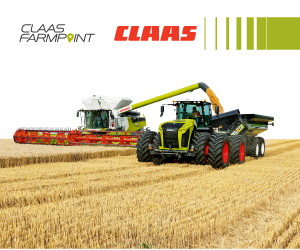Travelling down the I-65 in Indiana, I see many of you are deep into harvest.…

High-Tech Combines as Your Ally in Overcoming Today’s Farm Challenges
Editor’s note: This is part 2 of 2 posts about how the right combine can help overcome a range of challenges on today’s farms. Check out part 1 here!
5. Accessing Financial Resources:
Expanding the business or working on some of these solutions requires access to capital. And it is namely essential for farm expansion and modernization too. According to the Federal Reserve Bank of St. Louis, agricultural lending in the region for buying new technology equipment has increased in recent years, reflecting strong demand for credit among farmers to continuously improve productivity.
The main four ag equipment financial companies for loans and leases are:
- AGCO: https://www.agcocorp.com/finance.html
- CLAAS Financial Services (CFS): https://www.claasofamerica.com/sales-financing/cfs-usa
- Joint venture with BMO (Bank of Montreal).
- CNH: https://www.cnhindustrialcapital.com/en_us
- John Deere: https://www.deere.com/en/finance/financing/
After comparing the available options by list price minus trade-in adjusting like-for-like specifications and value calculator (1), loan payment options from these firms are built on APR (annual percentage interest rate) and timeline up to normally seven years. In addition, payment credits applied by some ag equipment financial companies to reduce the annual payment significantly could easily outweigh the interest difference. My recommendation is to always request the detailed structure of yearly payment net of payment credits (if it’s yearly what you want) and calculate the total amount paid over the loan period to have a transparent understanding of the offers in front of you. Leases are another possible relevant financing alternative but, given the actual rates, they have been minimal in last years and left for specific business needs.
Additionally, other entities such as government assistance programs, and grants are available to help farmers finance equipment purchases, land acquisitions and infrastructure improvements. Notoriously, the USDA’s Farm Service Agency and rural development programs offer a range of financial assistance options for eligible farmers.
6. Navigating Regulatory Compliance & Technology:
As you are well aware, several environmental regulations are increasingly impacting all ag operations. One of the reasons for the new regulations might be explained by the Indiana Department of Environmental Management, which identified that nutrient runoff from agricultural land is a significant contributor to water quality issues in the region.
This global trend was initiated mainly in Europe with the European Union’s first environmental laws. This had a big implication for the “carbon footprint” (2) that European combine manufacturers (first) and U.S.-based (later), making them take several measures to help farmers comply with regulatory requirements.
Here are some initiatives and technologies being implemented:
- Emissions Reduction Technology:
- Engines that meet or exceed emissions standards set by regulatory authorities like CLAAS Dynamic power.
- Advanced engine designs, exhaust after-treatment systems (such as selective catalytic reduction and diesel particulate filters), and improved fuel efficiency contribute to lower emissions and reduced environmental impact.
- Precision Agriculture Features:
- Precision agriculture technologies integrated into combines help farmers optimize resource use and minimize environmental impact. These features include GPS-guided steering systems, yield monitoring sensors and variable rate application capabilities.
- By precisely mapping field conditions and adjusting harvesting parameters in real time, farmers can optimize crop yields, minimize soil compaction and reduce input usage, contributing to sustainable farming practices and regulatory compliance.
- Safety Enhancements:
- Safety features to protect operators and bystanders. This includes incorporating advanced driver assistance systems (ADAS) such as collision avoidance systems, proximity sensors, and camera systems to enhance visibility and mitigate the risk of accidents.
- Ergonomic design improvements, such as adjustable operator seats, intuitive control interfaces and improved cab ventilation systems, contribute to operator comfort and safety during long hours of operation.
- Telematics and Data Management:
- Telematics systems enable remote monitoring, diagnostics and data management. Farmers can track equipment performance, monitor fuel consumption, and receive alerts for maintenance needs or potential issues.
- Data analytics tools analyze machine data to optimize equipment usage, identify efficiency improvements, and ensure compliance with maintenance schedules and regulatory requirements.
- Training and Support:
- Training programs and support services to help farmers operate their equipment safely and effectively while complying with regulatory requirements.
- Training initiatives cover topics such as equipment operation, maintenance procedures, safety protocols and regulatory compliance standards. Manufacturers also offer technical support and troubleshooting assistance to address farmers’ questions and concerns.
It is no surprise that because of regulations, productivity and efficiency, technology has played a big part in the changes in how a combine is run today. And we understand that it could be overwhelming sometimes the amount of screens, buttons and switches any 2024 model cab has. We will discuss technology further in our last point.

7. Embracing Technology:
Only in the last 15 years, technology has been accelerating all significant improvements in the yearly farming cycle, and this has resulted in clear yield increases and helped overcome some of the challenges just mentioned. Having said this, the adoption by all of us sometimes is too much to take in! Don’t you feel that it’s going too fast? Just when you start to be comfortable with one new “feature,” immediately comes an improvement that requires retraining to profit from it the most.
Combine manufacturers are helping farmers overcome the challenge of embracing technology with confidence by creating integrated technology platforms, user-friendly interfaces (e.g., CEBIS from CLAAS), onboarding training and support (first-day-of-use and direct contact to manufacturers’ product specialists), demonstration and education programs that provide hands-on learning (field demonstrations, workshops and seminars), and customization and adaptability that cater to the unique needs and preferences of individual farmers (modular design architectures, configurable settings and aftermarket upgrades).
Overall, it is said that combine harvesters serve as catalysts for technological adoption in agriculture by providing farmers with the tools, resources, and support needed to embrace innovation and enhance farm efficiency and productivity. From my point of view, it is important to mention too that when comparing combine manufacturers, you need to visualize which brand could best help overcome the barriers to technology adoption and leverage the transformative potential of advanced ag technologies.
In conclusion, while our beloved farming life in Indiana and Kentucky presents its share of challenges, we can rest assured that proactive management strategies and access to resources can help you overcome these obstacles and thrive in a dynamic agricultural landscape. By embracing innovation, collaboration, sustainability and, why not, studying value-added readings, you can position yourselves for success and ensure the continued prosperity of agriculture.
—————————
Written by Patricio L. Frangella.
Head of Commercial Development, CLAAS FARMPOINT
Patricio.frangella@claas.com
—————————-
(1) Value calculator (in days and $ / harvest year): savings comparison of specific combine manufacturers and models over a series of key performance elements, including ground speed, capacity, maintenance costs, fuel consumption, grain loss, grain tank capacity and unload rate. Request a free Excel sample of the value calculator to Farmpoint@claas.com.
(2)Carbon footprint: the total emission volume of greenhouse gases that trap and release heat and contribute to climate change. https://www.conservation.org/stories/what-is-a-carbon-footprint
References
- United States Department of Agriculture (USDA). (n.d.). Climate Change and Agriculture in the United States: Effects and Adaptation. [Online] Available at: https://www.usda.gov/oce/climate_change/effects_2012/Ag_Overview.htm
- Purdue University Extension. (2021). Extreme Weather Events Impact Agriculture. [Online] Available at: https://extension.purdue.edu/extmedia/ID/ID-462-W.pdf
- Natural Resources Conservation Service (NRCS). (n.d.). Soil Erosion Rates by State. [Online] Available at: https://www.nrcs.usda.gov/wps/portal/nrcs/detail/soils/use/?cid=nrcs142p2_054016
- University of Kentucky Extension. (n.d.). Soil Testing for Kentucky Lawns, Gardens, Fruit, and Ornamentals. [Online] Available at: https://www.uky.edu/Ag/CCD/soiltest/soiltestform.htm
- Kentucky Department of Agriculture. (n.d.). Kentucky Agriculture Pests. [Online] Available at: https://www.kyagr.com/statevet/plant-pest.html
- University of Kentucky College of Agriculture, Food, and Environment. (n.d.). Integrated Pest Management. [Online] Available at: https://entomology.ca.uky.edu/ipm
- Indiana State Department of Agriculture. (n.d.). Diversification of Marketing Channels. [Online] Available at: https://www.in.gov/isda/2563.htm
- Kentucky Center for Agriculture and Rural Development. (n.d.). Value-Added Agriculture. [Online] Available at: https://www.kcard.info/value-added-agriculture.html
- United States Department of Agriculture (USDA), National Agricultural Statistics Service. (n.d.). Farm Labor. [Online] Available at: https://www.nass.usda.gov/Surveys/Guide_to_NASS_Surveys/Farm_Labor/index.php
- Kentucky Farm Bureau. (n.d.). Employment Law Resources. [Online] Available at: https://www.kyfb.com/federation/employment-law-resources/
- Federal Reserve Bank of St. Louis. (n.d.). Agricultural Finance. [Online] Available at: https://www.stlouisfed.org/publications/central-banker/spring-2017/agricultural-finance
- United States Department of Agriculture (USDA), Farm Service Agency. (n.d.). Farm Loans. [Online] Available at: https://www.fsa.usda.gov/programs-and-services/farm-loan-programs/
- Indiana Department of Environmental Management. (n.d.). Agriculture – Nonpoint Source Pollution Control. [Online] Available at: https://www.in.gov/idem/nps/2348.htm
- Kentucky Division of Conservation. (n.d.). Cost-Share Programs. [Online] Available at: https://eec.ky.gov/Natural-Resources/Conservation/Pages/Cost-Share-Programs.aspx
- United States Department of Agriculture (USDA), Agricultural Resource Management Survey. (n.d.). Farm Investment and Financial Performance. [Online] Available at: https://www.ers.usda.gov/data-products/agricultural-resource-management-survey/
- American Farm Bureau Federation. (n.d.). Precision Agriculture. [Online] Available at: https://www.fb.org/issues/technology/precision-agriculture
- Purdue Center for Commercial Agriculture. (n.d.). Agricultural Technology Research and Extension. [Online] Available at: https://ag.purdue.edu/commercialag/home/Pages/default.aspx
- National Farm Transition Network. (n.d.). Succession Planning. [Online] Available at: https://farmtransition.org/succession-planning/
